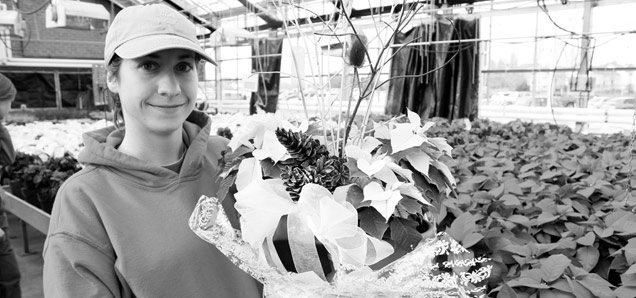Poinsettias splash colour across campus
 CREDIT: ERIKA FAUST
CREDIT: ERIKA FAUSTMiranda Reichstein is one of the many second-year Horticulture Technician students who have spent the last few months working to grow 1,000 poinsettias. The plants are on sale now, and all proceeds will benefit the program.
Fanshawe's Horticulture Technician students' months of hard work have paid off: the greenhouse in N-building is bursting with beautiful poinsettias, on sale now.
Summer students planted 1,000 poinsettias at the beginning of August and tended to them until the fall semester students took over in September. The plants need special care in order to grow properly, and the Horticulture Technician students explained that the most important part of growing poinsettias is photoinduction, meaning that the amount of light the plans receive must be monitored carefully. "It's 60 days of eight hours of darkness and then (it has to be) bright for the rest of the time," explained second-year student Alyssa LaCroix. "At 5 p.m., we have to close the curtains every single day until 8 a.m. the next morning. If you disturb it, they won't turn (colours) — they don't actually have a flower, it's the leaves that turn." Once regular day cycles are introduced, the plants stop growing.
The Horticulture program made a commitment to keep the plants pesticide-free, and used natural methods — such as predator bugs like swirski mites — to keep hungry or disease-bearing pests at bay.
Poinsettias have a long history of being associated with Christmas, and their story begins in 16th-century Mexico. The traditional story goes that a young girl, too poor to provide a gift for the celebration of Jesus' birthday, was inspired by an angel to gather weeds and place them at the altar of a church. As she did, bright red blossoms sprouted from the weeds and became what we now call poinsettias. The plants enjoyed popularity for centuries in Mexico and were brought to America in the 1800s. They have been a soughtafter Christmas plant in North America ever since.
If cared for properly, the plants will last through the holiday season and beyond. The poinsettias should receive around 300mL of water, or just enough to drip out of the bottom a little bit, but be sure to let the soil dry out between waterings. The plants should be watered approximately every three days. Be sure to put the plant in a sunny room. "They like bright light, but not direct light; if you put them right in a windowsill, they could get fried," warned LaCroix.
You may have heard rumours that these plants are highly poisonous to your family pets. While you probably shouldn't serve your cat or dog a feast of poinsettia leaves, the plants are only mildly toxic to housepets, according to the Pet Poison Hotline. In fact, holiday bouquets containing lilies, holly or mistletoe are far more dangerous when ingested.
The plants have been on sale since early November, and the sale will continue until December 7. Head to the N-building greenhouse (located behind M building) during the week — the best time to come is between 11 a.m. and 5 p.m. on Fridays. Poinsettias are $7.99 each, or three for $20. Plants in decorative baskets are priced at $19.99 each.
The money made from the sale of each plant goes to the horticulture program. "We do pay for the poinsettias and we grow them from seedlings, so we're making the money back as well as making money for our program, because we do grow everything that we have from seedlings, for the most part," explained second-year student Laura Hill.













